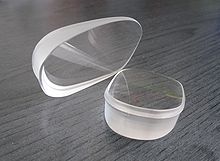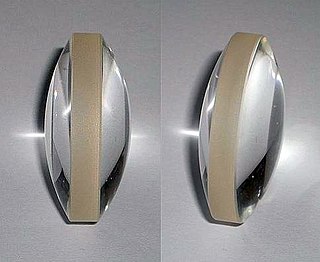
A lens is a transmissive optical device which focuses or disperses a light beam by means of refraction. A simple lens consists of a single piece of transparent material, while a compound lens consists of several simple lenses (elements), usually arranged along a common axis. Lenses are made from materials such as glass or plastic, and are ground and polished or molded to a desired shape. A lens can focus light to form an image, unlike a prism, which refracts light without focusing. Devices that similarly focus or disperse waves and radiation other than visible light are also called lenses, such as microwave lenses, electron lenses, acoustic lenses, or explosive lenses.

A corrective lens is a lens that is typically worn in front of the eye to improve daily vision. The most common use is to treat refractive errors: myopia, hypermetropia, astigmatism, and presbyopia. Glasses or "spectacles" are worn on the face a short distance in front of the eye. Contact lenses are worn directly on the surface of the eye. Intraocular lenses are surgically implanted most commonly after cataract removal but can be used for purely refractive purposes.
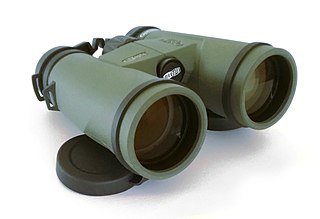
Binoculars or field glasses are two refracting telescopes mounted side-by-side and aligned to point in the same direction, allowing the viewer to use both eyes when viewing distant objects. Most binoculars are sized to be held using both hands, although sizes vary widely from opera glasses to large pedestal-mounted military models.
A dioptre or diopter is a unit of measurement with dimension of reciprocal length, equivalent to one reciprocal metre, 1 dioptre = 1 m−1. It is normally used to express the optical power of a lens or curved mirror, which is a physical quantity equal to the reciprocal of the focal length, expressed in metres. For example, a 3-dioptre lens brings parallel rays of light to focus at 1⁄3 metre. A flat window has an optical power of zero dioptres, as it does not cause light to converge or diverge. Dioptres are also sometimes used for other reciprocals of distance, particularly radii of curvature and the vergence of optical beams.
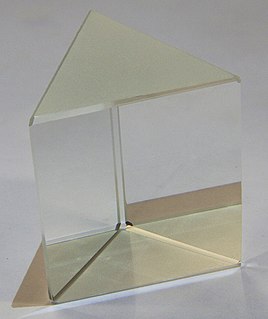
An optical prism is a transparent optical element with flat, polished surfaces that are designed to refract light. At least one surface must be angled — elements with two parallel surfaces are not prisms. The traditional geometrical shape of an optical prism is that of a triangular prism with a triangular base and rectangular sides, and in colloquial use "prism" usually refers to this type. Some types of optical prism are not in fact in the shape of geometric prisms. Prisms can be made from any material that is transparent to the wavelengths for which they are designed. Typical materials include glass, acrylic and fluorite.

Presbyopia is physiological insufficiency of accommodation associated with the aging of the eye that results in progressively worsening ability to focus clearly on close objects. Also known as age-related farsightedness, it affects many adults over the age of 40. A common sign of presbyopia is difficulty reading small print which results in having to hold reading material farther away. Other symptoms associated can be headaches and eyestrain. Different people will have different degrees of problems. Other types of refractive errors may exist at the same time as presbyopia. This condition is similar to hypermetropia or far-sightedness which starts in childhood and exhibits similar symptoms of blur in the vision for close objects.

An eyeglass prescription is an order written by an eyewear prescriber, such as an optometrist, that specifies the value of all parameters the prescriber has deemed necessary to construct and/or dispense corrective lenses appropriate for a patient. If an eye examination indicates that corrective lenses are appropriate, the prescriber generally provides the patient with an eyewear prescription at the conclusion of the exam.

Progressive lenses, also called multifocal lenses, progressive addition lenses (PAL), varifocal lenses, progressive power lenses, graduated prescription lenses, or progressive spectacle lenses are corrective lenses used in eyeglasses to correct presbyopia and other disorders of accommodation. They are characterised by a gradient of increasing lens power, added to the wearer's correction for the other refractive errors. The gradient starts at the wearer's distance prescription at the top of the lens and reaches a maximum addition power, or the full reading addition, at the bottom of the lens. The length of the progressive power gradient on the lens surface depends on the design of the lens, with a final addition power between 0.75 and 3.50 dioptres. The addition value prescribed depends on the level of presbyopia of the patient. In general the older the patient, the higher the addition.

An eye examination is a series of tests performed to assess vision and ability to focus on and discern objects. It also includes other tests and examinations pertaining to the eyes. Eye examinations are primarily performed by an optometrist, ophthalmologist, or an orthoptist. Health care professionals often recommend that all people should have periodic and thorough eye examinations as part of routine primary care, especially since many eye diseases are asymptomatic.
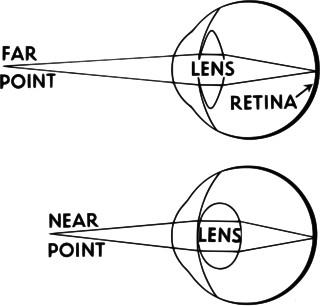
Accommodation is the process by which the vertebrate eye changes optical power to maintain a clear image or focus on an object as its distance varies. In this, distances vary for individuals from the far point—the maximum distance from the eye for which a clear image of an object can be seen, to the near point—the minimum distance for a clear image. Accommodation usually acts like a reflex, including part of the accommodation-vergence reflex, but it can also be consciously controlled. Mammals, birds and reptiles vary their eyes' optical power by changing the form of the elastic lens using the ciliary body. Fish and amphibians vary the power by changing the distance between a rigid lens and the retina with muscles.

A phoropter or refractor is an ophthalmic testing device. It is commonly used by eye care professionals during an eye examination, and contains different lenses used for refraction of the eye during sight testing, to measure an individual's refractive error and determine their eyeglass prescription. It also is used to measure the patients' phorias and ductions, which are characteristics of binocularity.

An aspheric lens or asphere is a lens whose surface profiles are not portions of a sphere or cylinder. In photography, a lens assembly that includes an aspheric element is often called an aspherical lens.

A lenticular lens is an array of lenses, designed so that when viewed from slightly different angles, different parts of the image underneath are shown. The most common example is the lenses used in lenticular printing, where the technology is used to give an illusion of depth, or to make images that appear to change or move as the image is viewed from different angles.

In optics, defocus is the aberration in which an image is simply out of focus. This aberration is familiar to anyone who has used a camera, videocamera, microscope, telescope, or binoculars. Optically, defocus refers to a translation of the focus along the optical axis away from the detection surface. In general, defocus reduces the sharpness and contrast of the image. What should be sharp, high-contrast edges in a scene become gradual transitions. Fine detail in the scene is blurred or even becomes invisible. Nearly all image-forming optical devices incorporate some form of focus adjustment to minimize defocus and maximize image quality.

A lensmeter or lensometer, is an ophthalmic instrument. It is mainly used by optometrists and opticians to verify the correct prescription in a pair of eyeglasses, to properly orient and mark uncut lenses, and to confirm the correct mounting of lenses in spectacle frames. Lensmeters can also verify the power of contact lenses, if a special lens support is used.
Adjustable focus eyeglasses are eyeglasses with an adjustable focal length. They compensate for refractive errors by providing variable focusing, allowing users to adjust them for desired distance or prescription, or both.
Vision of humans and other organisms depends on several organs such as the lens of the eye, and any vision correcting devices, which use optics to focus the image.
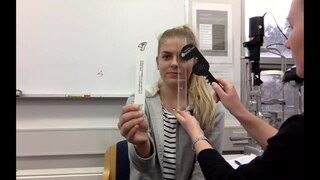
The prism cover test (PCT) is an objective measurement and the gold standard in measuring strabismus, i.e. ocular misalignment, or a deviation of the eye. It is used by ophthalmologists and orthoptists in order to measure the vertical and horizontal deviation and includes both manifest and latent components. Manifest is defined by the eye deviating constantly or intermittently, whereas latent is where the deviation is normally controlled but becomes present when the eyes are dissociated. A PCT reveals the total deviation and cannot distinguish between latent and manifest strabismus as you are using an alternate cover test.
The FourPrism Dioptre Reflex Test is an objective, non-dissociative test used to prove the alignment of both eyes by assessing motor fusion. Through the use of a 4 dioptre base out prism, diplopia is induced which is the driving force for the eyes to change fixation and therefore re-gain bifoveal fixation meaning, they overcome that amount of power.
A pyramid wavefront sensor is a type of a wavefront sensor. It measures the optical aberrations of an optical wavefront. This wavefront sensor uses a pyramidal prism with a large apex angle to split the beam into multiple parts at the geometric focus of a lens. A four-faceted prism, with its tip centered at the peak of the point spread function, will generate four identical pupil images in the absence of optical aberrations. In the presence of optical aberrations, the intensity distribution among the pupils will change. The local wavefront gradients can be obtained by recording the distribution of intensity in the pupil images. The wavefront aberrations can be evaluated from the estimated wavefront gradients.
